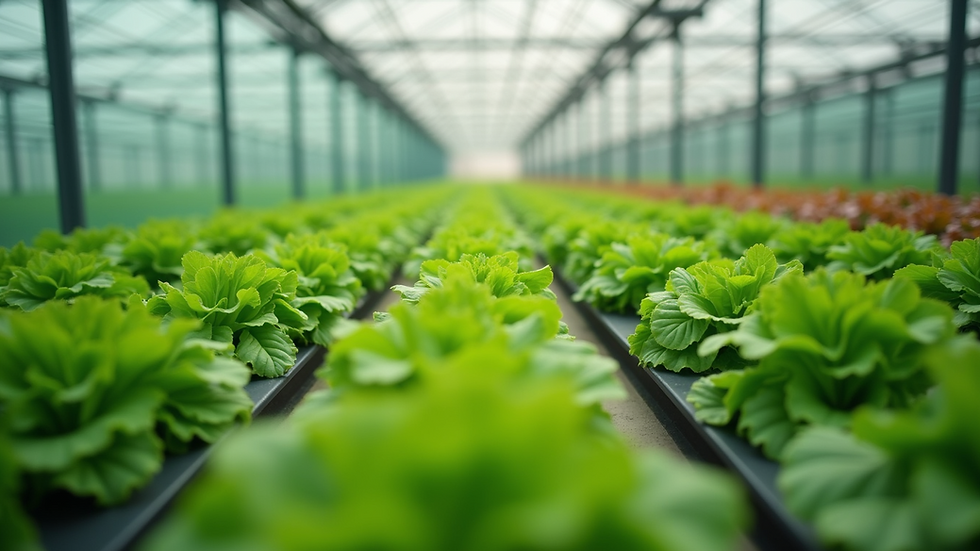Unveiling the Future of Microgreen Cultivation: Exploring innovative hydroponic and aeroponic techniques for the health-conscious generation
- Matthew Bowser
- Feb 21
- 4 min read
Microgreens are fast becoming a favorite for health-conscious individuals around the world. These tiny greens pack a punch with their high levels of vitamins and nutrients, making them a fantastic addition to any meal. As demand for sustainable food sources grows, methods like hydroponics and aeroponics are revolutionizing microgreen cultivation. This blog post takes you into the exciting world of these growing technologies, showing how they are transforming farming and ensuring fresh, healthy food is within everyone’s reach.
Understanding Microgreens
Microgreens are young, edible plants harvested shortly after the first leaves, or cotyledons, develop. Varieties such as kale, radish, arugula, and basil are popular for their bold flavors and impressive nutrient profiles. For example, mustard microgreens have been found to contain up to 40% more nutrients than their mature counterparts.
One of the main advantages of growing microgreens is their quick harvest time. You can typically expect to reap the rewards in just 7 to 21 days post-planting, depending on the type of microgreen and the conditions. This rapid growth makes them ideal for both home gardeners and commercial producers seeking high yields in shorter periods.
The Rise of Hydroponic Farming
Hydroponics allows plants to grow in a nutrient-rich water solution without the need for soil. This method is particularly efficient for cultivating microgreens, enabling optimal growth in well-controlled environments. Hydroponics is a game-changer for urban dwellers with limited growing space, offering a smaller footprint compared to traditional farming.
Hydroponic systems can be as simple as a small reservoir with a pump and net pots or more complex setups featuring advanced monitoring tools and nutrient delivery systems. The key benefits of hydroponic microgreens include:
Higher Yields: Plants absorb nutrients directly from the water, often growing faster than those in soil. Some hydroponic microgreens can yield up to 25% more per square foot compared to soil-grown varieties.
Water Efficiency: Hydroponics uses around 90% less water than conventional farming methods, which is crucial in drought-prone areas.
Space-Saving: Utilizing vertical setups allows for multi-layer planting, effectively maximizing space. Some growers report growing five times more microgreens in a vertical system than in a traditional flat garden plot.

Exploring Aeroponics
Aeroponics elevates the hydroponics concept by employing mist to supply water and nutrients to plant roots suspended in the air. This method creates an ideal environment for microgreens, allowing roots to access ample oxygen while staying water-rich.
Key benefits of aeroponics include:
Rapid Growth: Due to the high oxygen levels in the root zone, aeroponically grown microgreens can be ready for harvest even faster than those grown hydroponically, sometimes taking as little as 5 to 10 days.
Reduced Disease Risk: By limiting standing water and using a fine mist, aeroponics lowers the chances of root diseases commonly found in soil and hydroponic systems.
Increased Nutrient Efficiency: The direct delivery system of a nutrient-laden mist ensures that plants receive essential nutrients effectively, leading to vigorous growth.
Budgets for aspiring growers can also be friendly, as aeroponic systems can be constructed at relatively low costs, making them accessible for hobbyists.

Innovative Microgreen Growing Techniques
Beyond traditional hydroponic and aeroponic methods, several innovative approaches cater to the growing demand for microgreens. Here are a couple worth mentioning:
1. Kratky Method
The Kratky Method is a simple, low-cost hydroponic technique that uses no electricity or pumps. Seedlings float in nutrient-rich water, growing as the water level decreases. Ideal for beginners, this method offers a straightforward introduction to hydroponics with minimal investment.
2. Container Gardening
Container gardening blends traditional soil methods with modern techniques. Using soil-filled containers, you can cultivate microgreens on patios, balconies, or indoors. With the right mix and care, microgreens can thrive without the complexities of more advanced systems.

Choosing the Right Growing System
Deciding on the best microgreen growing method involves considerations like space, budget, and experience. Here are some tips to guide your decision:
Assess Your Space: Determine how much room you can dedicate to growing microgreens. If space is tight, consider vertical systems or aeroponic setups to maximize growth area.
Budget Wisely: Advanced hydroponic and aeroponic setups can be costly. Simple options, such as container gardening or the Kratky Method, are ideal for those with budget constraints.
The Future of Microgreen Farming
With the rise in interest for healthy, locally-sourced foods, innovative technologies for microgreens are set to thrive. These advancements not only make nutrient-rich greens more accessible but also support sustainable farming practices in urban areas.
From hydroponic to aeroponic systems, the future of microgreen cultivation is bright. Communities worldwide are adopting these technologies, developing urban farms that provide fresh produce directly to locals. This shift toward healthier eating presents a promising future for the next generation.
Embracing a Healthier Future
Microgreens deliver incredible health benefits and sustainability, enhanced by modern growing methods like hydroponics and aeroponics. Whether your goal is home gardening or enhancing your food business, understanding these methods can elevate your approach to fresh produce.
With their quick growth and concentrated nutrients, microgreens are not just a passing trend but a vital part of a healthy lifestyle. By embracing these technologies, we contribute to a healthier future. Whether you are a parent seeking nutritious meals for your family, an athlete aiming for peak performance, or simply a food enthusiast, the microgreen world has something for you.
Join the movement and explore the diverse possibilities that microgreens offer in our pursuit of healthy living!






Comments